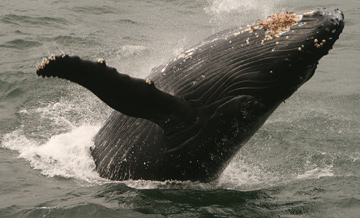Evolution of whales challenged
Origin of whales challenged
mongabay.com
December 19, 2007
Modern whales appear to have evolved from a raccoon-sized creature with the body of a small deer, according to scientists writing in the journal Nature. The results challenge the theory that cetaceans are descended from even-toed ungulates (artiodactyls) like hippos, as previous molecular analysis has suggested.
Analyzing a series of fossils, a team led by Hans Thewissen of Northeastern Ohio Universities Colleges of Medicine and Pharmacy have traced the closest land relative of today’s whales to Indohyus, a four-footed creature once found in India. The researchers found important similarities in the skull and ear fossil of Indohyus and present-day cetaceans, a family that includes whales, dolphins and porpoises.
 Photo by R. Butler |
The researchers say that these similarities, combined with other characteristics, suggest that Indohyus was a wading animal. Previously it was believed that whales descended from land-dwelling carnivores.
“Clearly, this is not the case. Indohyus is a plant eater, and clearly is aquatic,” said Thewissen. “Cetaceans originated from an Indohyus-like ancestor and switched to a diet of aquatic prey.”
The authors propose that Indohyus may have evaded land predators by fleeing into aquatic habitats, behavior seen today in the African mouse deer.
J. G. M. Thewissen et al (2007). Whales originated from aquatic artiodactyls in the Eocene epoch of India. Nature 450, 1190-1194 (20 December 2007) | doi:10.1038/nature06343;
Abstract from Nature: Although the first ten million years of whale evolution are documented by a remarkable series of fossil skeletons, the link to the ancestor of cetaceans has been missing. It was known that whales are related to even-toed ungulates (artiodactyls), but until now no artiodactyls were morphologically close to early whales. Here we show that the Eocene south Asian raoellid artiodactyls are the sister group to whales. The raoellid Indohyus is similar to whales, and unlike other artiodactyls, in the structure of its ears and premolars, in the density of its limb bones and in the stable-oxygen-isotope composition of its teeth. We also show that a major dietary change occurred during the transition from artiodactyls to whales and that raoellids were aquatic waders. This indicates that aquatic life in this lineage occurred before the origin of the order Cetacea.














